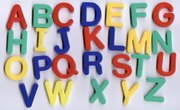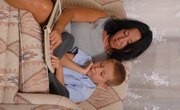As soon as sounds are learned, children can incorporate sounds into words. Before they can blend sounds together, they must know consonant and first vowel sounds. According to Connie Juel, a research specialist in literacy acquisition, before a child can learn to read, he must understand that words are composed of sounds that represent letters. Children can learn how to blend sounds together to form consonant/vowel/consonant words with activities that are concrete and fun.
Bumper Cars Blending
This fun game gives kids an entertaining way to practice blending CVC words. Cut two bumper cars out of cardboard and place them on a track that is also made of cardboard. Place a small pocket on the side of each car. Use green index cards with consonant letters printed on them and blue cards for the vowels. Read the story "Cat Nap" to the students in a group. Review all the sounds each letter makes. Model the blending activity by putting a consonant and a vowel in the same car. Move it on the track and have it bump into another consonant. When the cars bump together, the students see that the consonant and the vowel blend together to make a word. The consonant "c" allows the vowel "a" to ride in the car with him. When they bump into "t" or "p" or another consonant, a word is formed. This hands-on activity gives the kids a concrete visual.
Matching Game
Make a set of picture cards and word cards for up to six players. Find pictures of simple objects, like a cat or dog, or other pictures representing words with the CVC pattern. Give each player the same number of cards. Place word cards face down in a stack. Players take turns drawing a word card and reading it. The player who holds the matching picture card gets to place her card in the discard pile. The winner is the one to get rid of all of her picture cards. This activity requires the students to recognize the words with the CVC pattern, read the word and match the word to a picture.
Shaving Cream Words
This activity provides hands-on practice in listening and writing CVC words. Spray each student's desk with enough shaving cream for writing. Read some words with the CVC pattern, but do not say the letters, just the sounds. For example, "c-a-t" or "t-o-p" would be sounded out by emphasizing the sounds in the words. The students are to write the letters with their fingers in the shaving cream. This activity teaches sound discrimination and letter formation of CVC words. The shaving cream allows students to "erase" mistakes and start over and makes a great medium to work with. It also cleans their desks at the same time.
Related Articles
References
Writer Bio
Linda Woolhether is a retired teacher born in Texas, but now resides in Wyoming. Her career as a reading and writing teacher spanned 20-plus years. She holds a Master of Arts in education in curriculum and instruction and is experienced in various types of writing. She was successful in writing several educational grants while teaching. Completing a novel is presently her goal.











